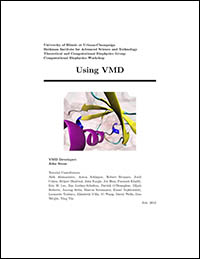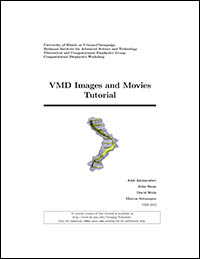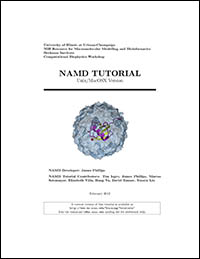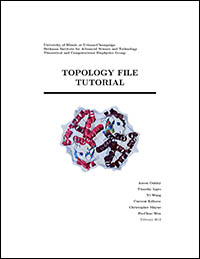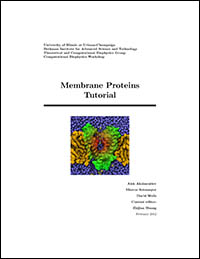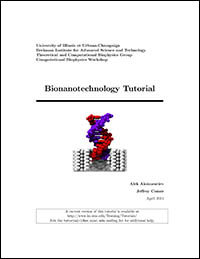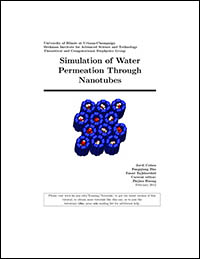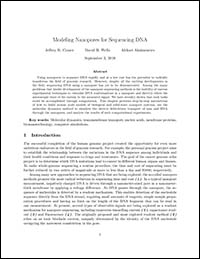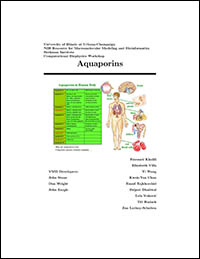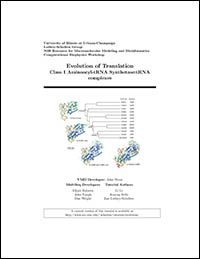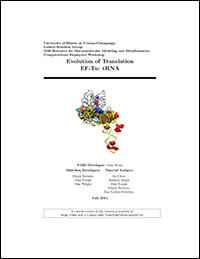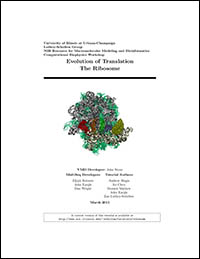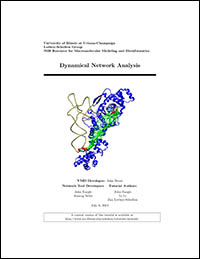Computational Biophysics Workshop - San Diego, September 21-25, 2015
Tutorials
In the hands-on afternoon sessions, you will have the option to work on a variety of tutorials. The tutorials recommended for this workshop are listed below. You can find a list of all existing tutorials
here.
Using VMD:
- Participants build an image of ubiquitin while becoming familiar with basic VMD commands. Additionally, participants learn how to look for interesting structural properties of proteins using VMD. Tutorial works on Windows, Mac, and Unix/Linux platforms.
- Instructions: [html] [pdf, 1.4M]
- Required tutorial files: [.tar.gz, 44.9M], [.zip, 44.9M], [individual files]
VMD Images and Movies Tutorial:
- This tutorial is designed to give users of VMD an introduction to advanced techniques for making custom images and movies. The first section looks at how to use features such as resolution, color, and material, depth perception, and volumetric data to produce effects and enhancements for still images. The second part demonstrates how to work with trajectories, by using techniques such as smoothing trajectories, showing multiple frames at once, and making atom selections "follow" a trajectory. It also shows how to create a movie file from a trajectory using VMD's Movie Maker plugin. Tutorial works on Windows, Mac, and Unix/Linux platforms.
- Instructions: [html] [pdf, 26.1M]
- Required tutorial files: [.tar.gz, 88.0M], [.zip, 88.0M], [individual files]
NAMD Tutorial:
Topology File Tutorial:
- Guides users in how to create topology and parameter information needed for molecular dynamics simulations when it otherwise doesn't exist, by using existing topology information for other molecules without the need for new parameter development. Requires VMD, NAMD suggested as well. Tutorial works on Windows, Mac, and Unix/Linux platforms.
- Instructions: [html] [pdf, 4.4M]
- Required tutorial files: [.tar.gz, 11.2M], [.zip, 11.2M], [individual files]
Membrane Proteins Tutorial:
- Step by step tutorial for setting up and running molecular dynamics simulations of membrane proteins. Requires VMD, NAMD, and Solvate. Tutorial works on Unix/Linux platform.
- Instructions: [pdf, 1.0M]
- Required tutorial files: reduced version [.tar.gz, 10.2M]; full version, [.tar.gz, 508M]
Bionanotechnology Tutorial:
- This tutorial is designed to guide users of VMD and NAMD in all the steps required to set up a molecular dynamics simulation of a bionanotechnology device. Tutorial works on Windows, Mac, and Unix/Linux platforms.
- Instructions: [html] [pdf, 2.9M]
- Required tutorial files: [.tar.gz, 189M], [.zip, 186M], [individual files]
Simulation of Water Permeation through Nanotubes:
- Investigates the permeation of water through nanotubes, as a model for transmembrane permeation of substrates through channels. Requires VMD and the AutoIMD extension to VMD. Tutorial works on Windows, Mac, and Unix/Linux platforms.
- Instructions: [html] [pdf, 435k]
- Required tutorial files: [.tar.gz, 39.8M], [.zip, 39.8M], [individual files]
Modeling Nanopores for Sequencing DNA:
-
This tutorial provides step-by-step instructions of how to build atomic scale models of biological and solid-state nanopore systems, using the molecular dynamics method to simulate the electric field-driven transport of ions and DNA through the nanopores, and analyze the results of such computational experiments. The tutorial is designed for use on Unix/Linux platforms, but will work on any system with working installations of VMD and NAMD.
- Instructions: [pdf, 15M]
- Required tutorial files: [.tar.gz, 277M]
Aquaporins with the VMD MultiSeq Tool:
- For users seeking to learn about a specific use of VMD. Introduces participants to the VMD MultiSeq Tool, which links protein structures to protein sequences and allows users to compare proteins in terms of structure and sequence. The aquaporin family of membrane proteins, found in a wide range of species including humans, are used for a case study of the applications of the MultiSeq tool. Requires VMD and the VMD MultiSeq Tool. Tutorial works on Windows, Mac, and Unix/Linux platforms.
- Instructions: [html] [pdf, 1.9M]
- Required tutorial files: [.tar.gz, 151M], [.zip, 151M], [individual files]
Evolution of Translation: Class-I aminoacyl-tRNA synthetases:
- This tutorial makes use of the MultiSeq bioinformatic analysis environment to explore the evolution of the class I aminoacyl-tRNA synthetases, which 'charge' transfer RNA (tRNA) with the correct amino acid. It is intended to be an introduction to MultiSeq, and no prior knowledge of MultiSeq is required. Topics covered include: BLAST searches, multiple sequence alignments, structural alignments, and distance-based phylogenetic trees.
- Instructions: [pdf, 6.4 MB]
- Required tutorial files: [tar.gz, 268 MB]]
Evolution of Translation: EF-Tu:
- This tutorial is intended to be an advanced lesson in the MultiSeq bioinformatic analysis environment, and we recommend the user first go through the Class-I Aminoacyl-tRNA synthetases tutorial prior to attempting this one. In it you will explore the evolutionary relationship of the elongation factor Tu, which ferries 'charged' tRNA from the sythetase to the ribosome. Topics covered include: profile-profile alignments, maximum likelihood phylogenetic trees with RAxML, and scripting with MultiSeq.
- Instructions: [pdf, 3.7 MB]
- Required tutorial files: [tar.gz, 284 MB]
Evolution of Translation: Ribosome:
- This tutorial leads the reader through major features of the ribosome, the primary translation machinery of the cell. Interactions with the elongation factors, mRNA, and tRNA are explored, as are newly discovered 'sequence signatures' between bacterial and archaeal ribosomes. These signatures constitute much of the evolutionary distance between these two domains of life, and their role in antibiotic resistance is explored. We recommend the reader first complete the Class-I aminoacyl-tRNA synthetase tutorial prior to attempting this one.
- Instructions: [pdf, 1.3 MB]
- Required tutorial files: [tar.gz, 41 MB]
Dynamical Network Analysis:
- This tutorial introduces several network analysis methods for examining dynamic signaling in biomolecular systems. The NetworkView plugin to VMD is used to display and manipulate representations of the networks projected onto the underlying molecular structures. The tutorial is designed such that it can be used by both new and experienced users of VMD, however, it is highly recommended that new users go through the "Using VMD" tutorial in order to gain a working knowledge of the program. Users will also need to download the free Carma software program for the tutorial. This tutorial should take about two hours to complete in its entirety.
- Instructions: [pdf, 4M]
- Required tutorial files: [tar.gz, 192M]; network analysis code [tar.gz, 27M]
